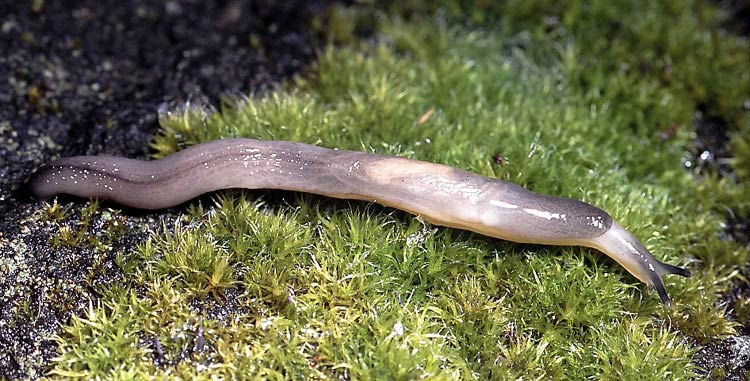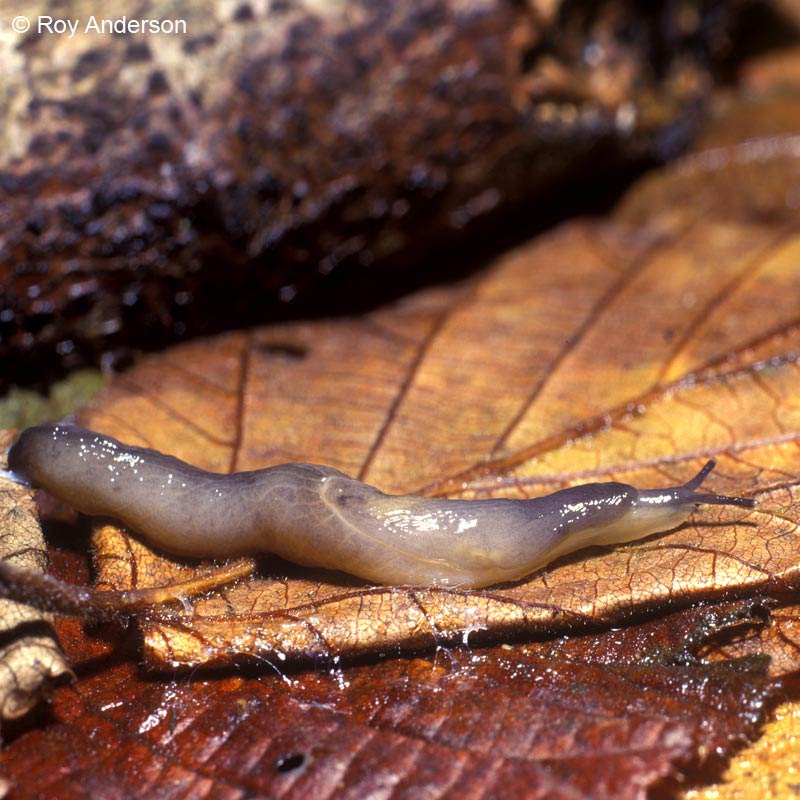Boettgerilla pallens
|
Boettgerilla pallens. (Photo: © K. Ovaska, CalPhotos) |
|
Boettgerilla pallens. (Photo: © Dr. Roy Anderson, MolluscIreland) |
|
Boettgerilla pallens. (Photo: © Dr. Roy Anderson, MolluscIreland) |
|
Boettgerilla pallens: pale yellow juvenile. (Photo: © Dr. Roy Anderson, MolluscIreland) |
Family
Boettgerillidae
Species
Boettgerilla pallens Simroth, 1912
Common name
Wormslug
Description
The wormslug is very narrow in appearance. It has the ability to measure up to 60 mm when fully extended, although individuals measuring between 30-40 mm are more common. The slug's color varies form a pale yellow to grey to blue-grey. In most individuals the back, mantleMantle:
A fleshy, membranous covering of the anterior portion of the body of a mollusc. It secretes the materials that form the shell.
, headHead:
The area of a mollusc's body that has the tentacles, eyes and mouth.
and tentaclesTentacles:
Sensory projections on the head end of a mollusc. There are generally two pairs; upper (posterior) and smaller, lower (anterior). The upper pair bears the eyes. In many snails the eyes are located at the tips of this structure; however, in Basommatophoran snail species, the eyes are located at the base of the tentacles.
are slightly darker than the rest of the body. The sole of the footFoot:
The muscular organ on the undersurface of the body of a mollusc upon which the animal rests or uses to crawl.
is a pale yellow-grey and produces a clear mucus. The keelKeel:
Also known as the carina. This is a longitudinal ridge that runs dorsally along the apex of the tail of the animal.
of this slugSlug:
A snail that either does not possess a shell or has one that is very reduced (no definite coiling) or internal.
extends from the tip of the tail to the posteriorPosterior:
Directional term: the rear or tail end of an animal.
edge of the mantleMantle:
A fleshy, membranous covering of the anterior portion of the body of a mollusc. It secretes the materials that form the shell.
. The juveniles of this species are much paler than the adults and in some cases may be pale grey-white.
Native range
Southeastern Europe
Distribution
North America:
- Canada: British Columbia
South America: Columbia
Europe
Ecology
The wormslug can be found in greenhouses, gardens, recreational areas, natural areas and nurseries. It is often found in the soil, and is capable of burrowing as deep as 60 cm. It may also occupy burrows made by earthworms. The diet of this slugSlug:
A snail that either does not possess a shell or has one that is very reduced (no definite coiling) or internal.
includes fungi, detritusDetritus:
Disintegrated organic material e.g. decaying leaves.
material, carrion and eggs of other terrestrial mollusks. This slugSlug:
A snail that either does not possess a shell or has one that is very reduced (no definite coiling) or internal.
also consume plant roots, and are thus an important nursery and greenhouse pest.
Synonyms
- Boettgerilla vermiformis Wiktor, 1959. Simroth 1912: 55, pl. 3, fig. 50, pl. 8, fig. 32
References
Anderson 2005Anderson 2005:
Anderson, R. 2005. An annotated list of the non-marine Mollusca of Britain and Ireland. Journal of Conchology 38: 607-637.; Grimm et al. 2009Grimm et al. 2009:
Grimm, F.W., R.G. Frosyth, F.W. Scheler and A. Karstad. 2009. Indentifying land snails and slugs in Canada. Introduced species and native genera. Canada Food Inspection Agency. Ottawa, ON. pp. 1-168.; Gunn 1992Gunn 1992:
Gunn, A. 1992. The ecology of the introduced slug Boettgerilla pallens (Simroth) in North Wales. Journal of Molluscan Studies 58: 449-453.; Horsák et al. 2004Horsák et al. 2004:
Horsák, M., L. Dvorák and L. Juricková. 2004. Greenhouse gastropods of the Czech Republic: current stage of research. Malacological Newsletter 22: 141-147.; Kantor et al. 2009Kantor et al. 2009:
Kantor, Y.I., M.V. Vinarski, A.A. Schileyko and A.V. Sysoev. 2009. Catalogue of the continental mollusks of Russia and adjacent territories. Version 2.1. (Accessed online July 20, 2010); Kerney et al. 1979Kerney et al. 1979:
Kerney, M.P., R.A.D. Cameron and G. Riley. 1979. A field guide to the land snails of Britain and North-west Europe. Collins, London. pp. 288.; Reise et al. 2000Reise et al. 2000:
Reise, H., J.M.C. Hutchinson, R.G. Forsyth and T.J. Forsyth. 2000. The ecology and rapid spread of the terrestrial slug Boettgerilla pallens in Europe with reference to its recent discovery in North America. The Veliger 43(4): 313-318.





